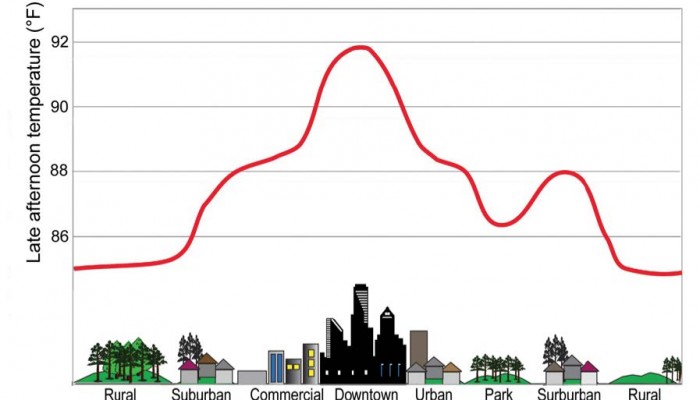
The 9th International Conference on Urban Climate and the 12th Urban Environment Symposium are taking place this week in the “Pink City” Toulouse. With the 21st Conference of Parties (COP21) which will be held in December in Paris, the obvious focus topic for the urban climate conference is the mitigation and adaptation to climate change in urban environment.
But, first of all, why should we even care about the urban climate and environment? One of the most important phenomena related to the urban climate that was first described by Luke Howard (1833) is the Urban Heat Island. This effect is caused by the accumulation of heat due to the various construction materials (asphalts, tiles, bricks…) used in urban areas. At night the urban areas hence cool less than in a natural environment and this leads to a higher temperature than the surrounding rural areas (see Figure). The difference in temperature can be up ot 8 degrees for some cities and for particular period during the year. Besides the presence of buildings also cause a modification of the wind pattern in cities.
One “simple” example of the significant impact of these effects is for example change the heating /cooling use in cities. Building energy demand is directly correlated with the outside air temperature but also to the wind speed. Thus, as the temperature is higher in urban areas, there is a greater need for cooling demand in temperate or arid climate. However, even in moderate climate, during long heat wave (and this is expected to become more frequent with climate change!) it can be expected that the cooling energy demand will increase.
Since 2010, over 50% of the world population lives in urban areas and this figure is expected to rise to 75% in 2050 (UN, 20121). As more people live in cities, this means that the cities need to grow to accommodate for the additional population. Urban expansion and densification as well as the decrease in agricultural land are crucial development issues that need to be addressed.
This means that we have to understand the various processes influencing the meteorological parameters in these areas. Model and simulation tools are ways to understand these complex problems and can be very useful tools for decision makers as it is an easier way to analyse different planning scenarios. Many scientists are also working on monitoring and measuring various meteorological parameters with traditional equipment but also with newer methods using mobile phones and other sensors.
The combined effects mentioned above can raise a number of questions:
- With climate change in mind, how do we build more buildings consuming less energy to accommodate for the increasing population?
- We have seen, for ex. in the summer 2003, that a long heat wave can increase significantly the number of deaths among vulnerable urban population (elder and younger people as well as people with respiratory problems). How do we then make sure that the thermal comfort of the inhabitants is satisfied in cities?
- Finally, how do we make sure that we build, design and plan more sustainable cities to decrease the impact of air pollution, to integrate more green and vegetated spaces…
All of these questions are very difficult to answer as they are a combination of scientific research questions but also of policy and planning decision. Scientists and planners should hence work together to build more sustainable cities and to provide meaningful implementation of the different research solutions.
1UN. World Urbanization Prospects: The 2011 Revision, CD-ROM Edition. Technical report, Department of Economic and Social A_airs, Population Division, 2012.

Pingback: Atmospheric Sciences | Why should we care about the building energy consumptions?
Pingback: Comment pouvons-nous utiliser des modèles météorologiques pour améliorer les simulations énergétiques des bâtiments? | playfeed
Pingback: How can we use meteorological models to improve building energy simulations? - Reader